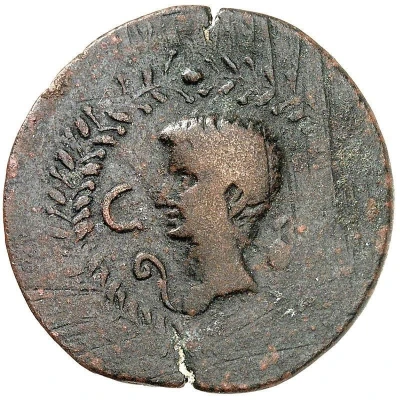


© Bibliothèque nationale de France / Gallica
Æ25–26 - Augustus Cithara 8 BC - 5 BC
| Bronze | 11.25 g | 32 mm |
| Issuer | Oea (Africa Proconsularis) |
|---|---|
| Emperor | Augustus (Caius Octavius) (27 BC - 14 AD) |
| Type | Standard circulation coin |
| Years | 8 BC - 5 BC |
| Composition | Bronze |
| Weight | 11.25 g |
| Diameter | 32 mm |
| Shape | Round (irregular) |
| Technique | Hammered |
| Orientation | Variable alignment ↺ |
| Demonetized | Yes |
| Updated | 2024-10-10 |
| Numista | N#374139 |
|---|---|
| Rarity index | 100% |
Reverse
Cithara (ancient stringed musical instrument). Beaded rim.
Script: Neo-Punic
Lettering:
𐤅𐤉𐤏𐤕
𐤈𐤈𐤉 𐤔𐤏𐤅𐤒
Edge
Bevelled
Comment
Denomination: possibly a heavy as, since the diameter corresponds to an as (RPC III page 206)Weight: 11.25 g average of 4 specimens (RPC III# 827; MAA#24)
Diameter: 28 mm (RPC III# 826 online); 25–26 mm (RPC III# 827; MAA#24)
Reverse inscription:
𐤅𐤉𐤏𐤕 (wyᶜt) above, in neo-Punic script, written right to left. Translates to Oea, the name of the city.
𐤈𐤈𐤉 𐤔𐤏𐤅𐤒 (ṭṭy šᶜwq) around, in neo-Punic script written right to left, representing the names of the two suffetes (magistrates). Müller wrongly assumes they represent the allied cities of Zitha (𐤈𐤈𐤉 / ṭṭy) and Zuchis (𐤔𐤏𐤅𐤒 / šᶜwq).
Interesting fact
The Augustus (Cithara) coin from Oea (Africa Proconsularis) features a unique design on its reverse side. Instead of the usual depiction of a Roman deity or a personification of a province, this coin features a cithara, a stringed musical instrument that was popular in ancient Rome. This suggests that the people of Oea may have had a strong cultural or artistic connection to music, and that the coin may have been issued to commemorate a musical event or festival.



